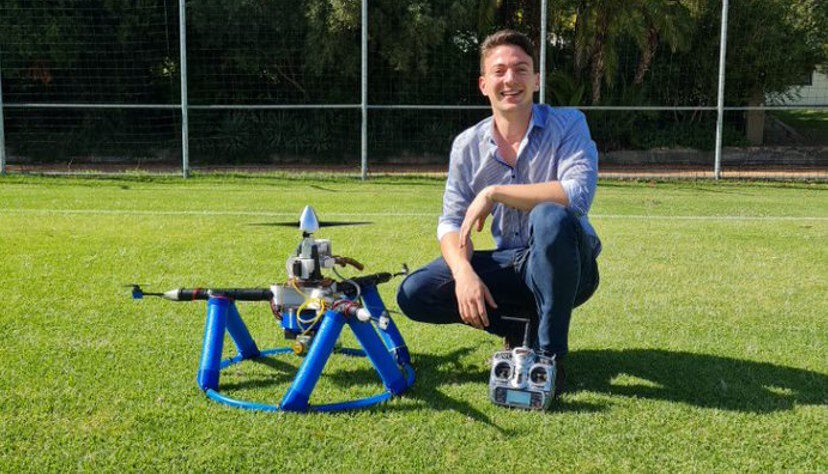Masters student, Waldo Wessels, builds a hybrid quadcopter
After proposing the research topic “Design, Build and Test a Quadcopter with a Novel Configuration for Endurance Flights” for a fifth year, Dr Willie Smit finally found an interested student.
Waldo Wessels, who since he received a soldering iron from his grandfather in Grade 1 loves designing and building. This inspired him to become an engineer and after finishing his undergraduate degree in Mechatronic Engineering, he wanted to improve and put his skills in electronic and mechanical engineering to the test. Since building a clap-clap switch at his student Residence room and building a voice-controlled home automation system he was ready to research, design and build a novel quadcopter for a master’s degree.
Before applying for the postgraduate degree, Waldo had to do some theoretical calculations as people in industry doubted that the design would work. He first had to ascertain that the drone would be able to fly and whether the design was a step ahead of the existing quadcopter designs.
Initially the quadcopter was only meant to be driven by electrical motors, however his theoretical power calculations proved that a petrol engine would maximize flight times.
The quadcopter became a hybrid quadcopter.
About the design he says, “Since the large central propeller is responsible for producing the majority of the lift in this novel configuration, and because rapid differential thrust variations is not required for roll, pitch and yaw, the large propeller was powered by a petrol engine. To counteract the counter torque like a conventional helicopter’s tail rotor, the electric motors were canted horizontally at a fixed angle. The small electric motors are responsible for roll, pitch and yaw control and stability.
Parts can be easily removed, fixed, and replaced.
Although designed to fit a camera in the front of the quadcopter, time constraints prevented the installation of a GPS and camera. For now, a normal quadcopter remote control is used instead of GPS.
Because of its chemical resistance to petrol the airframe is made up of carbon fiber tubes, plates, and 3D printed joints, printed from polyethylene terephthalate glycol (PETG). Low density polyethylene foam rods used in the landing gear were an additional benefit which acted as shock absorbers during hard landings.
Weighing 5.5 kg with the battery and a full tank of petrol there is an advantage, the drone becomes lighter while flying and using petrol, making it more efficient.
Waldo says that the main engine which creates most of the lift is a 20cc 2-stroke engine, a 17×6 inch carbon fiber propeller and carbon fiber tubes were purchased locally, but mostly sourced from overseas. He used 3 brushless DC motors with poly carbonate propellers as they have double the lifespan of brushed DC motors. A standard Pixhawk 4 flight controller, a lithium polymer battery, and electronic speed controllers were among the components required to complete his project.
Assembling was effortless and fast but waiting for some of the parts, especially the petrol engine, which was purchased during Covid took frustratingly long.
Asked what type of drone it is, Waldo says, “Despite the novel configuration it is still a quadcopter due to its four fixed pitch rotors. Because of the centre propeller’s counter torque, the landing gear of the drone required a unique design as normal quadcopter landing gear would have caused this quadcopter to tip over during take-off. A circular polypropylene tube at the base allowed the drone to slide on the takeoff surface which solved the problem and ensured take off with ease.
Despite the noisy engine, the drone can typically be used for search and rescue, package deliveries, agriculture and much more.
Waldo has much praise for his supervisor, Dr Smit, and other lecturers who shared their knowledge with him. He learnt through the problem solving the project presented. He thoroughly enjoyed designing and building but not so much writing up his thesis.






